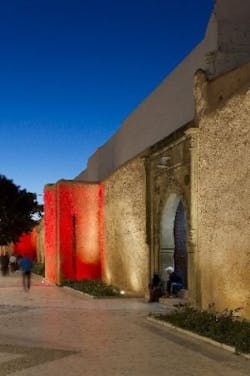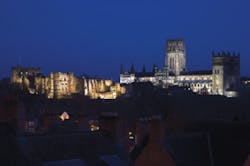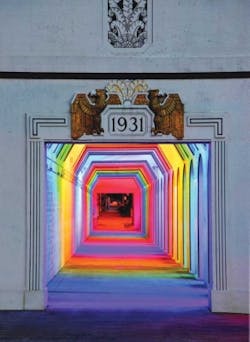Whenever I’m browsing through content to put together a topic newsletter, I am always struck by the enormous possibilities enabled by solid-state lighting (SSL). Let’s be extremely honest for a minute. I would have been much less aware of this extraordinary flexibility of design and function had I not been working with LEDs Magazine over the past four years. And I’ll say it again: I’ve never worked in a technician or engineering capacity. Unless you consider the wordsmithing a form of engineering. I was an English major by education and an editor by training. I have never built something from metal, adhesives, thermal materials, electronic circuits, and so on. So I’m fascinated by the end results of outdoor architectural and façade lighting projects especially, because each environment poses different challenging conditions. And the spaces, areas, or structures themselves serve a larger purpose into which that lighting needs to appear to fit seamlessly.
We have an architectural illumination newsletter going out on Monday (you can find a subscription form with all our newsletter offerings here). There are lots of great resources out there on architectural lighting. We don’t discount or debate that. But what sets our angle on architectural illumination apart is the continuous quest to determine how solid-state lighting enables form and function that couldn’t be achieved with traditional light sources. What makes LED-based architectural lighting so intriguing in this context?
There are examples that speak for themselves, which include the ability to design LEDs into more extreme environments such as the walls of Rabat in Morocco. While balancing the historical heritage of the site, the lighting designers had to take into account the climate, as well as the amount of traffic in the area and that fixtures would need to be very robust to handle shock and vibration. But I think you’ll admit the end result is a thing of beauty — highlighting the historic element of the walls like a masterpiece.
Norman monuments in Durham, England also received royal treatment courtesy of architectural lighting. Both of these projects mentioned are protected as United Nations Educational, Scientific and Cultural Organization (UNESCO) World Heritage Sites, which means project managers, lighting specifiers, and anyone else involved in a restoration, renovation, or retrofit of any kind must be extremely sensitive to the cultural, historical, and architectural significance of these places. Certainly, the castle and cathedral draw a fair amount of tourism and new lighting needed to showcase the structure details tastefully and beautifully. But the Durham location also had the charge of reducing light trespass and respecting the ambient environment for the wildlife present. The outdoor LED fixtures were positioned very deliberately so as not to disrupt the lines of the masonry, and beam distribution was a major design factor, with multiple beam angles designed in for both architectural highlights and pedestrian safety — without spilling over into the vegetation where animals would nest.
Moving beyond such dramatic historical challenges, across the Atlantic you can see the ingenuity required to enliven and rejuvenate an area of Birmingham, AL that had fallen into some state of disrepair. As a hub for railroad-driven industry in the 19th and 20th centuries, the city’s districts split by the railway were in need of re-gentrification after much of the industry died out. When completed, the city’s residents, as well as visitors, could feel secure in enjoying the attraction of the color-changing LightRails installation as it played off of the Art Deco architectural details of the pedestrian areas. The project not only uses less energy but it also provides a pleasing ambience without distracting drivers in the process.
These are just a few instances of “inspired illumination,” which would not have been made possible without the customizable and controllable aspects of LED technology. Targeted luminaires, clever infrastructure, and digital controls were brought together to elevate the aesthetics of these architectural monuments.








